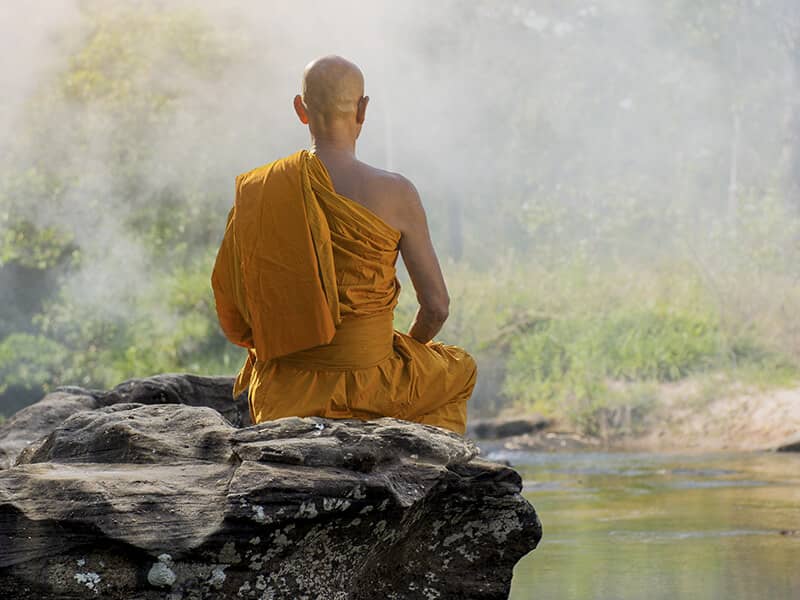In many ways, I am a modern-day komuso. The komuso were itinerant, mendicant priests of the Fuke-Shu sect of Zen Buddhism who wandered Japan during the Edo period (1600-1868). These priests were samurai who had lost their masters, and they would take the problems and illnesses of people upon themselves by playing a certain kind of shakuhachi music called Sui-Zen. The ko in komuso means "emptiness" or "nothingness," so the komuso were quite literally priests of the emptiness. They would wear tengai, a kind of woven basket, on their heads, hiding their faces. This was for anonymity, to suppress the ego. As selfless, empty vessels, other people's problems could be "poured" into them. When someone needed a komuso to play for healing, the patient would see only a flute extending from the bottom of the basket, not a person.

| ||
| The idea of shakuhachi is to become one with the music so that you experience no other distractions, worries, problems, illnesses, or stresses | ||
 |
The komuso wandered the breadth of the countryside. Many government agents disguised themselves as komuso, since one could travel about in complete anonymity and gather information. I even know a short piece that was supposed to be played by one komuso greeting another. If the second komuso did not respond, the first would know that the other was probably a spy. When the government changed, in order to eliminate the spy network, the Fuke sect was abolished and all its temples abandoned. It was only by good fortune that the repertoire of the Zen shakuhachi survived.
Zen literally means "meditation." The shakuhachi is the only melodic instrument used for meditation (as opposed to gongs, bells, and drum beats). When you simply sit in meditation, it's called zazen, or sitting meditation, and when you play shakuhachi to meditate, it's called suizen, or "blowing" meditation. The idea of this Zen art is to become one with the music so that you experience no other distractions, worries, problems, illnesses, or stresses.
The shakuhachi has existed in Japan for 1,200 years. At first it was used to play court music, or gagaku. The kind of shakuhachi music I play here is honkyoku, or music that is played for one's own enlightenment and that is an outgrowth of Zen Buddhism. The word honkyoku refers to "origin," hon. And origin, in this case, means the place inside yourself that is the origin of your being or the origin of the truth. Part of the purpose of this music is to promote unity between what is within you and your outward manifestation.
You can play shakuhachi music in the background of your daily life to create a peaceful environment. But to get the full benefit of this music, it is best to find a place where you have few distractions and where you can relax.
The music is designed to bring you to a state of balance. If you concentrate on it and allow it to become the center of your thought, you will become remarkably calm. Imagine that you are on a wonderful journey, walking through countryside you have never seen before. Try to appreciate every sound and silence as if it were a waterfall or a bird in flight or wind in a field of flowers. You are encountering it and not expecting to experience it again. Allow yourself to be delighted with it, to be struck by its beauty for the first (and last) time. This is hearing music in the Now. Listen for how a note begins and how it ends. Listen also for the space between sounds, called the ma, which means "space" or "emptiness." Listen for all the various textures in which the notes are played. The same notes can sound totally different depending on the tone, the way the note begins, what happens to it while it is sounding, how it ends, and the space in between. That is the aesthetic, and part of the Zen experience.
Try to breathe along with the music. Imagine that the flute is an extension of your breath, which is the most intimate part of you. Focus on the flute as if you were playing with it, making the breath that activates the note. The breathing is from the hara, the area two inches below the navel, which is considered the center of the body in many cultures.
The beginnings of many of the honkyoku pieces start with a few phrases in a low octave and are quite brief. As one enters more deeply into the blowing meditation, the phrases get longer and longer. Let them pull you into the meditative state; they are designed to do that, as it is the breathing exercise aspect of the music.
Both player and listeners can enter into a trance state through this music. My teacher used to say that if you are playing for a lot of people, just choose one person and play to their kokoro, their heart. On this recording, I am playing to your kokoro.The piece of music featured here is called Kyo-Choshi, a Meian-Style honkyoku. This honkyoku is played simply, without any unusual techniques. The word choshi means "tone," "condition," or "state of mind." It refers to the essential unity and harmony of the universe or to the state of mind when heaven, earth, and humanity are perceived as one. This version of choshi is from the Meian-Ji Temple in Kyoto.
Although all Zen pieces help to clear the mind, I believe that through deep listening to pieces such as "Kyo-Choshi" one can find further awareness and unity in one's thoughts and memories. That is why it is one of my favorite pieces to play for the mentally ill and the aged.

